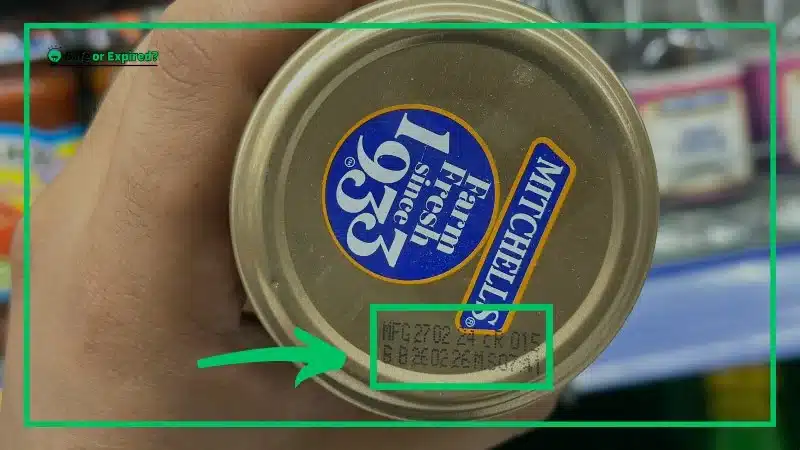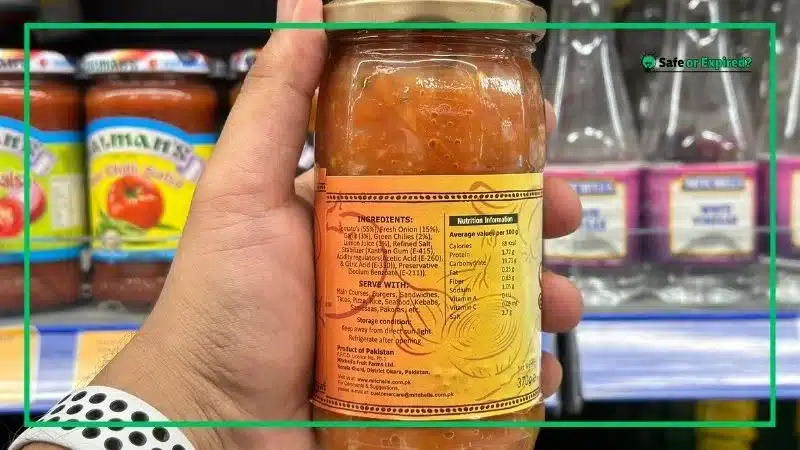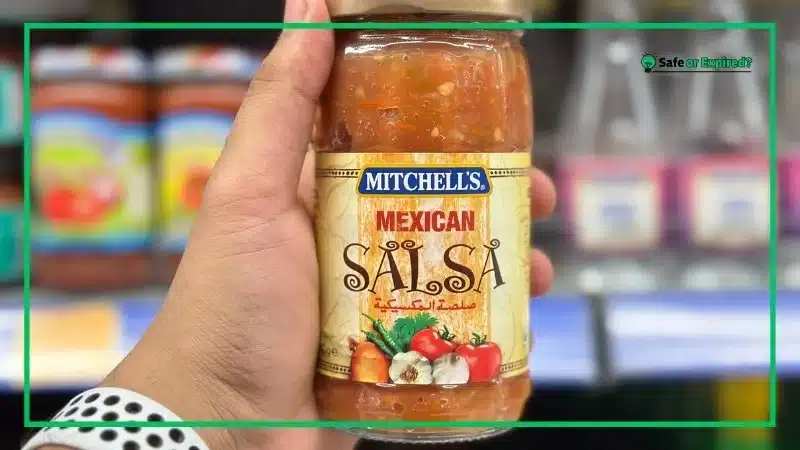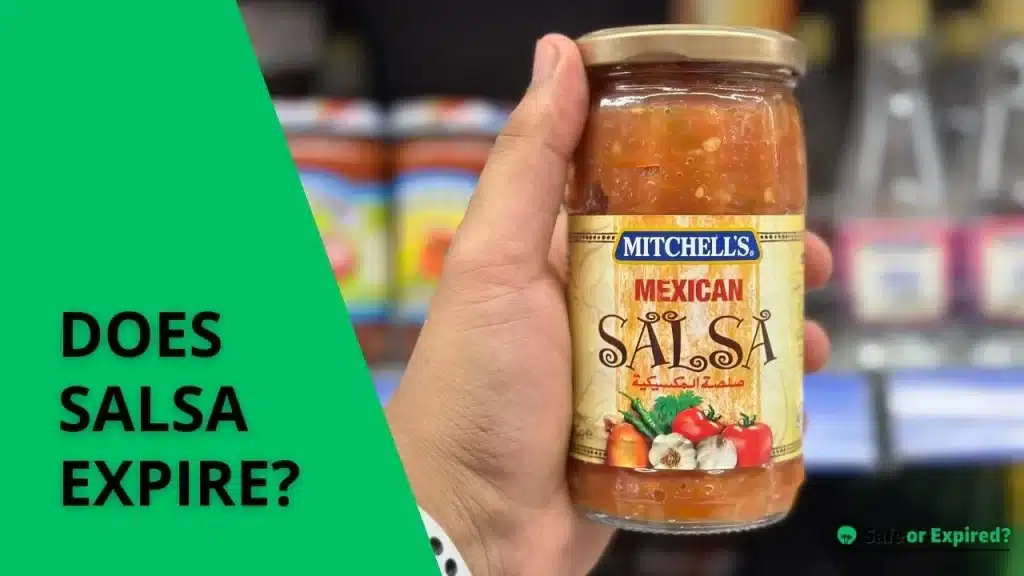Every chef wonders, “Does salsa expire?” at least once in their lifetime. Well, the short answer is – Absolutely, it does expire. However, knowing when it’s time to toss it can save you from a less-than-tasty experience!
Stick to the end to understand the telltale signs of bad salsa and whether you can use it after it expires.
Does Salsa Expire or not?
Yes, salsa does expire. Its shelf life is influenced by factors such as whether it’s homemade or store-bought, its ingredients, and how it’s stored. Store-bought salsa generally lasts longer due to preservatives. No matter what, always check the expiration/best-by date on the salsa bottle and try to use it before this “deadline.”

People often ask, “Does salsa expire fast? Salsa can expire quickly, especially if not stored properly. Homemade salsa, lacking preservatives, can begin to spoil within a few days after opening. Store-bought, on the other hand, has ingredients that can last longer.
You can see the list of salsa’s ingredients on its bottle.

Even store-bought salsa, once opened, should be consumed within a short period for optimal freshness. Keeping salsa refrigerated and tightly sealed helps maintain its quality and safety.
So, how long does salsa expire? The expiration of salsa depends on several factors including its type, storage conditions, and whether it has been opened.
- Unopened Jarred Salsa: When stored in a cool, dry place, it can last 12-18 months past its “best by” date.
- Opened Jarred Salsa: Once opened, refrigerate and consume within 5-7 days. If it’s fresh salsa from a store, aim for 4-7 days.
- Homemade Salsa: It usually lasts 4-6 days in the refrigerator.
Opened vs. Packed
One question I often receive is, “Does salsa expire after opening?” Yes, salsa expires after opening. Once opened, salsa should be consumed within a few days to a week, even when refrigerated, as exposure to air and contaminants can accelerate spoilage.
Many people also ask, “Does salsa expire if unopened?” Note that salsa does expire even if unopened. However, it maintains its quality for much longer compared to when it’s opened. The unopened salsa expiration date can vary based on the brand, ingredients, and preservatives used. To know, check the bottle.

Typically, unopened store-bought salsa can last well beyond its ‘best by’ date if stored in a cool, dark place. Always check the packaging for specific expiration information and store accordingly to ensure maximum shelf life.
Refrigerator vs No Refrigerator
The storage method has a significant impact on the lifespan of salsa. You may be wondering, Does salsa expire if not refrigerated? Yes, salsa expires much faster if not refrigerated. Without refrigeration, opened salsa can start to spoil within hours, especially in warm environments.
But does salsa expire in the fridge, too? Unfortunately, salsa does expire in the fridge, but it lasts significantly longer than when left out at room temperature. Properly refrigerated, salsa can stay fresh and safe to consume for several weeks after opening.
So, to sum up, does salsa go bad if not refrigerated? Salsa goes bad quickly if not refrigerated after opening. To ensure safety and quality, always store salsa in the refrigerator immediately after use.
Let me also answer this query, “Does salsa go bad at room temperature?” Salsa can go bad at room temperature, especially once opened. Exposure to warm temperatures accelerates the growth of bacteria and mold, potentially leading to spoilage within a day. For best results, keep unopened salsa in a cool, dark place and refrigerate after opening.”
Homemade vs Commercial
The shelf life of salsa varies significantly between homemade and commercial varieties due to differences in preparation, ingredients, and preservatives. So, how long is homemade salsa good for after opening?
Homemade salsa typically lasts about 5-7 days in the refrigerator, as it lacks the preservatives found in commercial products. In contrast, commercial salsa can last several months unopened due to preservatives and pasteurization processes that extend its shelf life. Once opened, both types should be consumed within a week to maintain quality and safety.”
Here’s a table showing the typical shelf life of salsa based on its type and storage conditions:
| Salsa Type | Storage Condition | Shelf Life |
| Unopened Jarred Salsa | Cool, dry place | 12-18 months after “best by” date |
| Opened Jarred Salsa | Refrigerated | 5-7 days |
| Fresh Store-bought Salsa | Refrigerated | 4-7 days |
| Homemade Salsa | Refrigerated | 4-6 days |
Does Tostitos Salsa Expire? Let’s Find Out
Yes, Tostitos salsa does expire. Unopened, it typically has a shelf life of several months up to a year, thanks to the preservatives used in its manufacturing. The exact expiration date can often be found on the packaging.
Once opened, Tostitos salsa should be consumed within 5 to 7 days. Always ensure the jar is tightly sealed after each use to maximize its shelf life and prevent spoilage.
Does Salsa Valentina Expire?
Yes, Salsa Valentina does expire. Similar to other commercial hot sauces, its high vinegar and salt content help preserve it for longer periods. Unopened, Salsa Valentina can last for 2-3 years if stored in a cool place.
Once opened, it should be consumed within six months for optimal flavor. However, note that it may remain safe to use beyond this if kept refrigerated. Its longevity, even after opening, is due to its preservative ingredients and acidity.
Does Jarred Salsa Expire?
Yes, jarred salsa does expire. The expiration date depends on the brand and the preservatives used during production. Generally, unopened jarred salsa can last up to 12-18 months when stored appropriately in a cool, dark place.
Once opened, it should be consumed within 1 to 2 weeks if kept refrigerated. Always check the jar for spoilage, such as mold, an unusual odor, or changes in texture before consuming.
Does Pace Salsa Expire?
Yes, Pace salsa does expire. Unopened, Pace salsa typically has a shelf life of about 12 to 18 months due to its preservation methods and packaging. The expiration date is usually printed on the jar and should be adhered to for best quality.
Once opened, it should be consumed within about two weeks and kept refrigerated to maintain freshness. Always inspect the salsa for any spoilage signs, such as an off smell or mold, before use.
Does Canned Salsa Expire? Yes or No?
Yes, canned salsa does expire. The canning process involves high heat to ensure sterility, which is why canned salsa typically has a longer shelf life compared to other types. Unopened, it can last for 2-3 years if stored correctly.
After opening, it should be consumed within 1 to 2 weeks and kept refrigerated. Always check for any signs of spoilage like rust on the can, leaks, or bulging before consuming.
Does Pace Chunky Salsa Expire?
Yes, Pace Chunky Salsa does expire. Its shelf life is similar to other Pace salsa products. Unopened, it can be stored for about 12 to 18 months, as indicated by the expiration date on the jar. Once opened, Pace Chunky Salsa should be consumed within about two weeks when refrigerated.
Ensure you tightly seal the lid after each use to maintain freshness and prevent spoilage, and always inspect the salsa for any signs of spoilage before eating.
How Long Does Unopened Salsa Last Past Expiration?
Yes, unopened salsa can often be safe to consume past its printed expiration date, especially if it has been stored properly in a dark place or pantry. Many types of commercial salsa can last 1 to 3 months beyond their expiration date if unopened.
However, it’s important to follow food safety guidelines and inspect the salsa for any signs of spoilage, such as an off smell, mold, or an altered appearance, before using it. For the best quality and safety, adhere to the expiration dates whenever possible.
Can I Use Salsa After the Expiration Date?
Yes, it can be safe to use salsa after its expiration date, particularly if it’s unopened and has been stored properly. However, it’s essential to check the salsa for signs of spoilage, such as mold, an unusual odor, or changes in color and texture before consuming.
If the salsa looks, smells, and tastes normal, it might still be okay to eat. Always use caution and prioritize food safety when consuming any food past its expiration date.
Here’s a simple table listing different ways to use salsa:
| Use | Description |
| Zesty Topping for Grilled Meats | Adds a bright, tangy taste to grilled chicken, steak, or fish. |
| Incorporate into Breakfast Dishes | Adds a spicy touch to scrambled eggs or omelets. |
| Use as a Dip for Snacks | Perfect as a dip with tortilla chips, crackers, or veggies. |
| Mix into Rice or Quinoa Dishes | Mix into cooked rice or quinoa for extra flavor. |
| Create Flavorful Stews and Soups | Makes stews and soups richer and more flavorful. |
| Dressing for Tacos or Fajitas | Great as a spicy dressing for tacos, fajitas, or burritos. |
Remember that maintaining both the quality and safety of your food enhances your dining experience. Discover how to manage this in “Balancing Quality and Safety in Food Handling.”
How to Know Salsa Has Gone Bad? Top Signs
The salsa that has gone bad will exhibit noticeable changes. Look for signs like an off smell, any visible mold growth, and changes in color or texture. A sour or unpleasant taste is also a clear indicator that the salsa should no longer be consumed.
Always inspect your salsa carefully before eating, especially if it’s been stored for a while or past its expiration date.
Off Smell
Fresh salsa should have a vibrant, tangy aroma. If the salsa smells sour, rancid, or generally unpleasant, it’s a strong indicator that it has started to spoil. This off smell is due to the activity of spoilage bacteria and yeast, which produce gasses and other byproducts as they break down the salsa’s organic components.
Visible Mold
Mold on salsa can appear as fuzzy spots or discolorations, with colors ranging from white to green or black. Moldy spots are a clear sign of spoilage and occur from exposure to air and mold spores in the environment. Salsa provides a moist, nutrient-rich environment in which mold thrives, especially if the salsa is improperly sealed or stored.
Changes in Color
Over time, salsa may darken or appear dull and discolored, indicating it has gone bad. This change in color can result from oxidation and the growth of microorganisms, which alter the salsa’s original appearance.
Altered Texture
If the texture of the salsa changes significantly, becoming excessively watery or unusually thick, it is likely spoiled. These texture changes can result from the breakdown of salsa components by bacteria, which can alter its consistency.
Unpleasant Taste
A sour or otherwise off-taste is a definitive sign that salsa should no longer be consumed. Spoiled salsa may have an acidic or fermented flavor that differs markedly from its fresh, zesty taste.
Each of these signs alone can indicate that your salsa has gone bad, but observing several signs together provides even stronger evidence. Always prioritize safety and discard any salsa that shows signs of spoilage.
Also, understanding the factors that cause food to spoil is essential for prevention. Read about them here – Why Do Food Spoils? 13 Common Reasons.
Conclusion
In conclusion, salsa does expire, and you learned all about it in detail here. Here are the key takeaways:
- Inspect Your Salsa: Always check for off smells, visible mold, and color changes.
- Store Properly: Keep unopened salsa in a cool, dark place and refrigerate after opening.
- Use By Dates: Pay attention to expiration dates, but also use your senses to judge salsa’s freshness.
- Refrigeration Is Key: Once opened, keeping salsa in the fridge is crucial to slow down the spoilage process.
- When in Doubt, Throw It Out: Discarding questionable salsa is better than risking foodborne illness.
By following these guidelines, you can enjoy your salsa safely up until the last dip!

